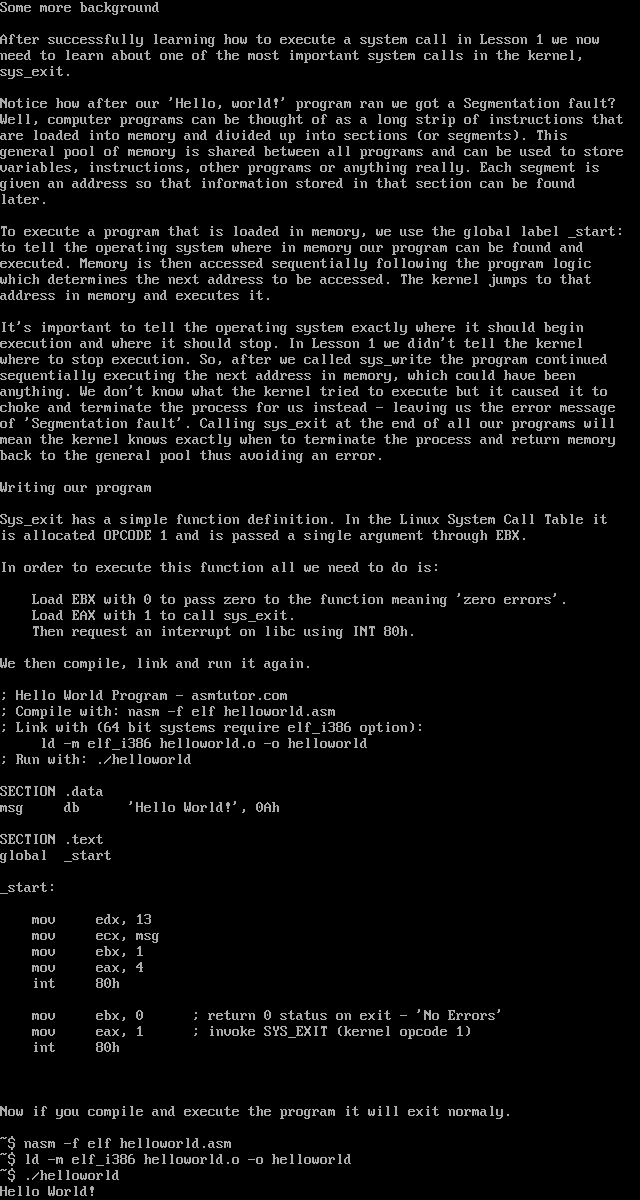
this image contains text
Some more background
After successfully learning how to execute a system call in Lesson 1 we now
need to learn about one of the most important system calls in the kernel,
sysexit.
Notice how after our Hello, world! program ran we got a Segmentation fault?
Well, computer programs can be thought of as a long strip of instructions that
are loaded into memory and divided up into sections or segments. This
general pool of memory is shared between all programs and can be used to store
variables, instructions, other programs or anything really. Each segment is
given an address so that information stored in that section can be found
later.
To execute a program that is loaded in memory, we use the global label start:
to tell the operating system where in memory our program can be found and
executed. Memory is then accessed sequentially following the program logic
which determines the next address to be accessed. The kernel jumps to that
address in memory and executes it.
Its important to tell the operating system exactly where it should begin
execution and where it should stop. In Lesson 1 we didnt tell the kernel
where to stop execution. So, after we called syswrite the program continued
sequentially executing the next address in memory, which could have been
anything. We dont know what the kernel tried to execute but it caused it to
choke and terminate the process for us instead - leaving us the error message
of Segmentation fault. Calling sysexit at the end of all our programs will
mean the kernel knows exactly when to terminate the process and return memory
back to the general pool thus avoiding an error.
Writing our program
Sysexit has a simple function definition. In the Linux System Call Table it
is allocated OPCODE 1 and is passed a single argument through EBX.
In order to execute this function all we need to do is:
Load EBX with 0 to pass zero to the function meaning zero errors.
Load EAX with 1 to call sysexit.
Then request an interrupt on libc using INT 80h.
We then compile, link and run it again.
Hello World Program - asmtutor.com
Compile with: nasm -f elf helloworld.asm
Link with 64 bit systems require elfi386 option:
ld -m elfi386 helloworld.o -o helloworld
Run with: ./helloworld
SECTION .data
msg db Hello World!, 0Ah
SECTION .text
global start
start:
mov edx, 13
mov ecx, msg
mov ebx, 1
mov eax, 4
int 80h
mov ebx, 0 return 0 status on exit - No Errors
mov eax, 1 invoke SYSEXIT kernel opcode 1
int 80h
Now if you compile and execute the program it will exit normaly.
nasm -f elf helloworld.asm
ld -m elfi386 helloworld.o -o helloworld
./helloworld
Hello World!
After successfully learning how to execute a system call in Lesson 1 we now
need to learn about one of the most important system calls in the kernel,
sysexit.
Notice how after our Hello, world! program ran we got a Segmentation fault?
Well, computer programs can be thought of as a long strip of instructions that
are loaded into memory and divided up into sections or segments. This
general pool of memory is shared between all programs and can be used to store
variables, instructions, other programs or anything really. Each segment is
given an address so that information stored in that section can be found
later.
To execute a program that is loaded in memory, we use the global label start:
to tell the operating system where in memory our program can be found and
executed. Memory is then accessed sequentially following the program logic
which determines the next address to be accessed. The kernel jumps to that
address in memory and executes it.
Its important to tell the operating system exactly where it should begin
execution and where it should stop. In Lesson 1 we didnt tell the kernel
where to stop execution. So, after we called syswrite the program continued
sequentially executing the next address in memory, which could have been
anything. We dont know what the kernel tried to execute but it caused it to
choke and terminate the process for us instead - leaving us the error message
of Segmentation fault. Calling sysexit at the end of all our programs will
mean the kernel knows exactly when to terminate the process and return memory
back to the general pool thus avoiding an error.
Writing our program
Sysexit has a simple function definition. In the Linux System Call Table it
is allocated OPCODE 1 and is passed a single argument through EBX.
In order to execute this function all we need to do is:
Load EBX with 0 to pass zero to the function meaning zero errors.
Load EAX with 1 to call sysexit.
Then request an interrupt on libc using INT 80h.
We then compile, link and run it again.
Hello World Program - asmtutor.com
Compile with: nasm -f elf helloworld.asm
Link with 64 bit systems require elfi386 option:
ld -m elfi386 helloworld.o -o helloworld
Run with: ./helloworld
SECTION .data
msg db Hello World!, 0Ah
SECTION .text
global start
start:
mov edx, 13
mov ecx, msg
mov ebx, 1
mov eax, 4
int 80h
mov ebx, 0 return 0 status on exit - No Errors
mov eax, 1 invoke SYSEXIT kernel opcode 1
int 80h
Now if you compile and execute the program it will exit normaly.
nasm -f elf helloworld.asm
ld -m elfi386 helloworld.o -o helloworld
./helloworld
Hello World!

log in to add a comment.